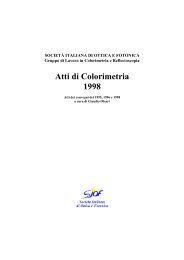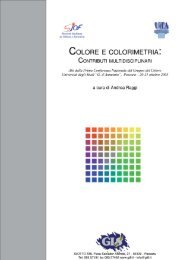Scarica gli atti - Gruppo del Colore
Scarica gli atti - Gruppo del Colore
Scarica gli atti - Gruppo del Colore
You also want an ePaper? Increase the reach of your titles
YUMPU automatically turns print PDFs into web optimized ePapers that Google loves.
and then ‘stitched together’ to form an image of the whole. This operation, which<br />
is called mosaicking, consists in finding corresponding details in overlapping<br />
tessels that cover adjacent areas of the scene, and then stitch those tessels together<br />
in such a way that the corresponding details perfectly overlap and the resulting<br />
composite image does not show any geometrical or color artifact, especially where<br />
the edges of the tessels were placed.<br />
Mosaicking has been extensively studied for wide-angle images like those<br />
obtained from aerial and satellite photography or panoramas taken with standard<br />
cameras (see for instance [19-21]). In these cases, tessels often show great<br />
geometrical distortions because of the lens characteristics, while the level of detail<br />
is sufficiently small, so that correcting large distortions can give good results even<br />
if some small-scale artifacts are still present. However, in many of the applications<br />
envisioned for multispectral imaging, the situation is usually different, with tessels<br />
that show very little to no geometrical distortions and are taken from slightly<br />
different view angles or slightly misaligned positions, especially on the vertical<br />
axis. On the other hand, the final mosaicked images are usually very sensitive to<br />
even small-scale artifacts. Anyway, no multispectral acquisition system can be<br />
considered complete if it does not include a framework for multispectral<br />
mosaicking.<br />
A typical approach in mosaicking is that of letting the user / operator indicate some<br />
overlapping details of two or more tessels, and then having the mosaicking<br />
software compute the corresponding mathematical transformations and produce<br />
the final mosaic. Image understanding and applied artificial intelligence techniques<br />
have also been tried to develop automated procedures that should be capable of<br />
choosing the right transformations without any intervention by the user. In these<br />
cases, however, results are mixed, as many kinds of artifacts and scenes do not<br />
lend themselves easily to this approach. Also, much research concentrated on<br />
panorama-like (i.e., horizontal) mosaicking, and the resulting algorithms perform<br />
poorly when confronted with bi-dimensional mosaicking (see Figure 5).<br />
On our part, we opted for a mixed approach and developed a semi-automatic<br />
procedure that gets input from the user under the form of corresponding areas, and<br />
then applies image analysis techniques to find the precise match to be used for<br />
computing image transformations (see Figure 6).<br />
Compared to other procedures that require single corresponding points to be<br />
indicated, this approach aims to reduce the impact of any errors caused by the<br />
limitations of the user inspection, which is performed by eye. Such errors, even<br />
when their magnitude is limited to a distance of very few pixels, may result in<br />
significantly distorted mosaicking, especially in those regions of the tessels which<br />
are distant from the detail considered.<br />
As a reference, Figure 7 shows a mosaic obtained by the authors through the<br />
application of this procedure.<br />
34





